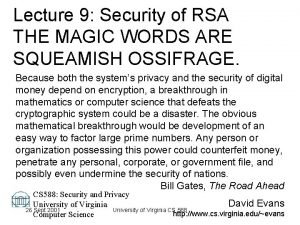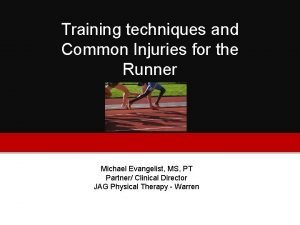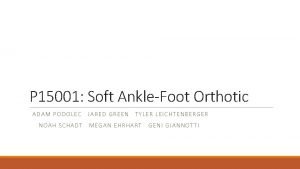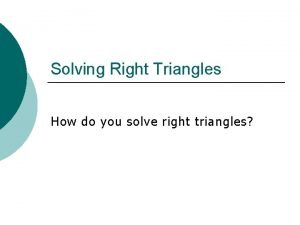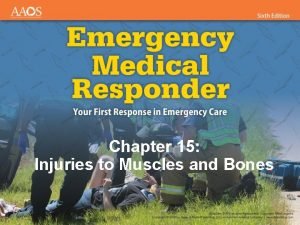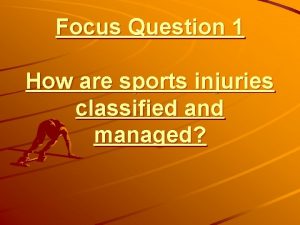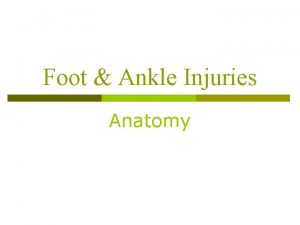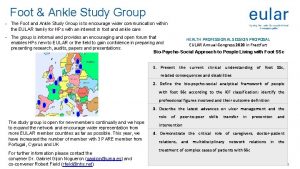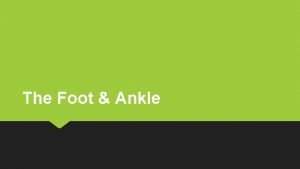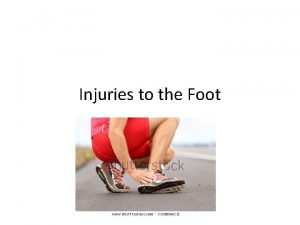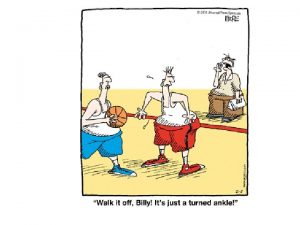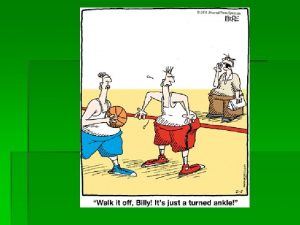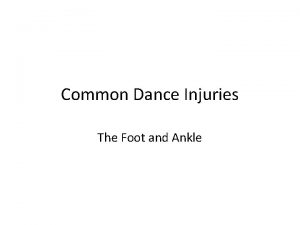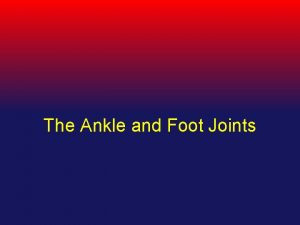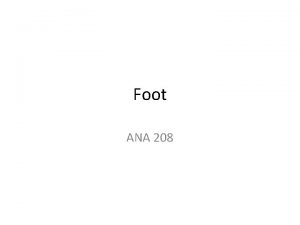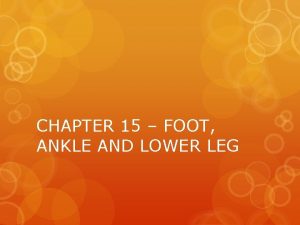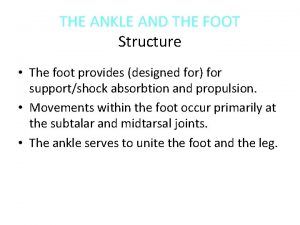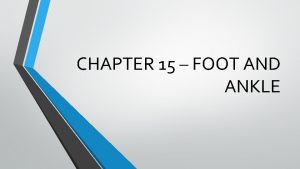FOOT AND ANKLE COMMON INJURIES SQUEAMISH Rolltwisted ankle


















- Slides: 18

FOOT AND ANKLE COMMON INJURIES

SQUEAMISH? • Roll/twisted ankle: • http: //www. youtube. com/watch? v=lg. Nttdd 7 UIc • Breaking ankle: • http: //www. youtube. com/watch? v=v. A 5 BU 045 gi 4

BONES • S&S • • • Pain Decreased ROM Swelling Bruising NWB Obvious deformity

BONES • Any bone • Acute fx • Stress fx • Avulsion fx • Jones Fx • Fx of the styloid process of the 5 th Metatarsal • Union vs non-union • Knock-Off Fx


LIGAMENTS/TENDONS • Ligament: bone to bone • Tendon: muscle to bone • Grading system: • 1+/-: stretched, but no tearing/fraying of fibers • 2+/-: tearing, but incomplete • 3: complete tear

CONT’D • Signs & Symptoms: • • Pain Swelling Decreased ROM Increased temp of skin Bruising NWB + laxity test

CONT’D • ATFL– Candy if you can name it! • Most commonly sprained • MOI – “rolling ankle”, stepping in hole • Deltoid Ligament • • Keep ankle from evertion; stronger than ATF MOI – Stepping in hole High Ankle Sprain – Syndesmotic Sprain MOI - Dorsiflexion and evertion • Achilles Tendon • More commonly torn with age • MOI – Forced Dorsiflexion with knee bent

MUSCLES • Strain • Grade 1, 2, 3 • Common muscles affected: • Peroneals • Calf

“SHIN SPLINTS” • Medial tibial stress syndrome (MTSS) • Caused by: • Irritated and swollen muscles, often from overuse • Stress fractures, which are tiny breaks in the lower leg bones • Overpronation or ''flat feet" -- when the impact of a step makes your foot's arch collapses • Runners might get them after ramping up their workout intensity, or changing the surface they run on

• Treatment: • Rest your body. It needs time to heal. • Ice your shin to ease pain and swelling. Do it for 2 mins every 3 to 4 hours for 2 to 3 days, or until the pain is gone. • Anti-inflammatory painkillers. NSAIDs • Arch supports for your shoes. These orthotics -- which can be custom-made or bought off the shelf -- may help with flat feet. • Range-of-motion exercises • Neoprene sleeve for support. • Physical therapy to strengthen the muscles in your shins.

YOU KNOW IT’S HEALED WHEN. . • Your injured leg is as flexible as your other leg. • Your injured leg feels as strong as your other leg. • Your can jog, sprint, and jump without pain. • Your X-rays are normal or show any stress fractures have healed. • There's no way to say exactly when your shin splints will go away. It depends on what's causing them. People also heal at different rates; 3 to 6 months is not unusual.

DIAGNOSIS PROCESS • HOPS: • History • Observation • Palpation – Provides a reference for the comparison of bilateral symmetry of bones, alignment, tissue temperature, or other deformity as well as the presence of increased tendernesss • Joint and Muscle Functional Assessment – impairment due to ROM, Strength, P with movement • Joint Stability Tests – reference for laxity, gapping, hypo/hypermobility, end-feel • Special Test

MANUAL MUSCLE TESTING • Patient position: Muscle tested must be against gravity • Examiner position: stabilize proximal to the joint being tested and provide resistance to the distal joint • “Break test” • Positive test: weakness and/or pain compared contralateral

GRADING • 5/5 Normal: can resist max pressure with no pain • 4/5 Good: can resist moderate pressure • 3/5 Fair: Can move body part against gravity thru full ROM • 2/5 poor: Can move body part in gravity-eliminated position thru full ROM • 1/5 Trace: cannot produce movement, but muscle contraction is palpable • 0/5 Zero: No contraction is felt

END-FEEL (NORMAL) • Soft: soft tissue approximation ex: knee flexion • Firm: Muscular stretch/Capsular Stretch/Ligamentous Stretch ex: Hip flexion, Ext of MCP joints in fingers, forearm supination • Hard: bone to bone ex: Elbow ext

END-FEEL (PATHOLOGICAL) • Soft: occurs sooner or later in ROM than normal in a joint that normally has a firm or hard end-feel ex: edema/synovitis • Firm: occurs sooner or later in ROM than normal in a joint that normally has soft or hard end-feel ex: Capsular/muscular/ligamentous shortening • Hard: occurs sooner or later in ROM than normal in a joint that normally has soft or firm end-feel; feels like a bony block ex: Loose bodies in joint/myositis ossificans/fx • Spams: Joint motion is stopped involuntarily or voluntary muscle spasm ex: inflammation/strain/joint instability • Empty: no end-feel bc end of ROM is never reached due to pain; no resistance felt except for patient’s protective muscle splinting or muscle spams ex: fx/brusitis/abscess

HOMEWORK • Pages 4 and 5 in coloring packet
 The magic words are rsa
The magic words are rsa Physiology of the foot and ankle
Physiology of the foot and ankle Common track injuries
Common track injuries Ankle foot orthoses
Ankle foot orthoses Foot orthosis instant design
Foot orthosis instant design You put your right foot in
You put your right foot in Solving right triangles
Solving right triangles Unit 15:10 providing first aid for specific injuries
Unit 15:10 providing first aid for specific injuries A short backboard or vest-style immobilization
A short backboard or vest-style immobilization Chapter 21 caring for head and spine injuries
Chapter 21 caring for head and spine injuries Injuries to muscles and bones chapter 15
Injuries to muscles and bones chapter 15 Chapter 14:1 using body mechanics
Chapter 14:1 using body mechanics Jones and bartlett learning
Jones and bartlett learning Chapter 13:2 preventing accidents and injuries
Chapter 13:2 preventing accidents and injuries Chapter 11 assessment and evaluation of sports injuries
Chapter 11 assessment and evaluation of sports injuries Chapter 12 lesson 2 improving your fitness
Chapter 12 lesson 2 improving your fitness How are sports injuries classified and managed
How are sports injuries classified and managed Common factors of 18 and 30
Common factors of 18 and 30 Common anode and common cathode
Common anode and common cathode
